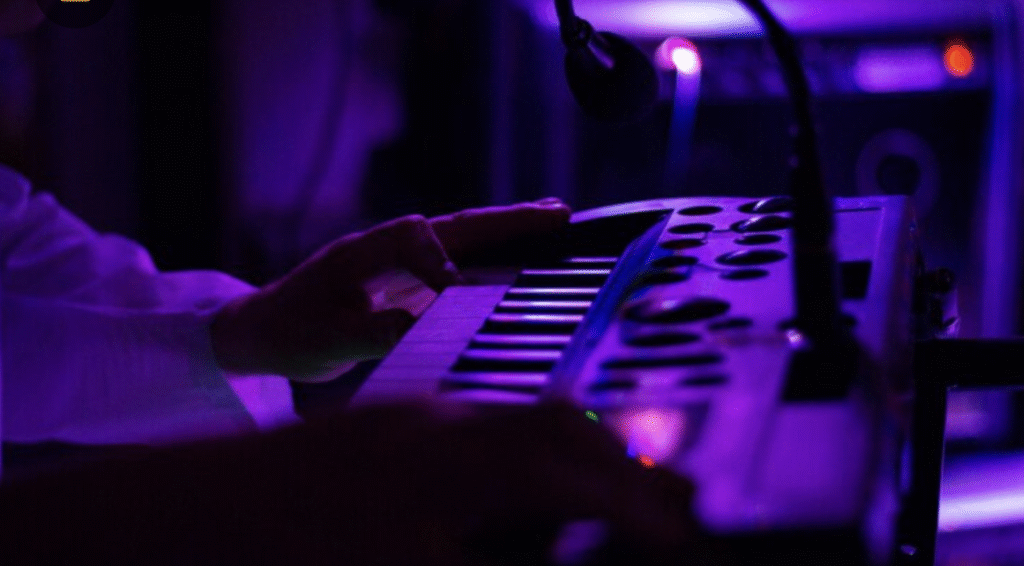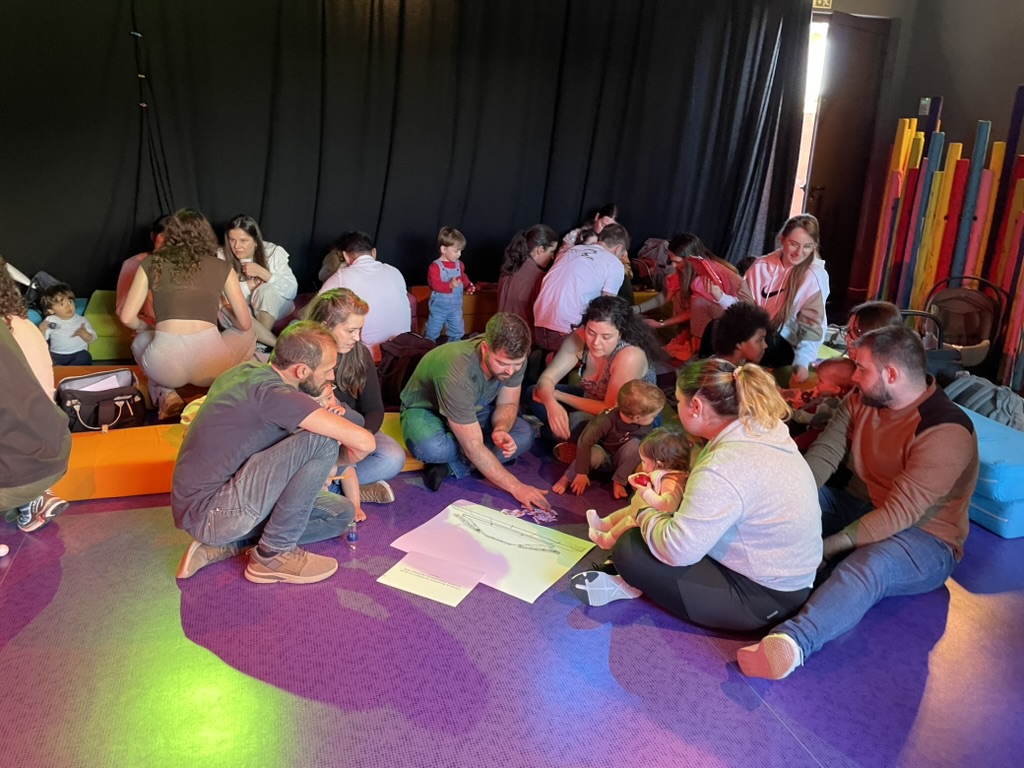The sound of innovation: the long relationship between music and technology
by François Matarasso
28 February 2025
“Just as photography changed the way we see, recording technology changed the way we hear. Before recorded music became ubiquitous, music was, for most people, something we did.”
David Byrne, How Music Works
The story of music is inescapably also a story of technological innovation. Although music still retains its original naked power – the sound of a voice, perhaps accompanied by handclaps, can be as meaningful today as it was at the dawn of time – the art form’s evolution has been shaped by a succession of technological breakthroughs.
The composer Howard Goodall calls these moments ‘Big Bangs’ in his book of the same name, and describes five that he sees as fundamental to the evolution of Western music.
- The invention of musical notation by Guido of Arezzo, a 10th century Italian monk, enabled the formal teaching and conservation of music which had until then depended on ear and memory. It also contributed to the dominance of interpretation over improvisation in European art music.
- The invention of opera, which arrived fully formed in its first masterpiece, Monteverdi’s L’Orfeo, performed in Mantua in 1607, and established a art that has dominated high culture ever since.
- The invention of equal temperament, the mathematical tuning system that differentiates European music from all other musics, demonstrated by J. S. Bach in The Well-Tempered Clavier (1722) with keyboard pieces written in all the major and minor keys.
- The invention of the piano by Bartolomeo Cristofori (c. 1700) created the foundational tool of music creation and composition, and democratised music by bringing a professional instrument into public places, bars and the homes of working people.
- The invention of recorded sound by Thomas Edison and others transformed the way music was experienced, displacing the live concert and eventually making it possible to hear almost any music, anywhere, at any time so that it became the soundtrack to people’s lives.
Goodall’s big bangs are only some of the many times when technology has changed the nature of music, its place in social, cultural and economic life, and what it means to us. One could also mention the popularity of the piano accordion in the 19th century, which stifled the still unusual tunings of folk music, or how more powerful instruments nurtured the symphonic ambitions.
More recently the invention of digital streaming has undermined the livelihoods of professional musicians while enriching technology corporations. The current battle over AI is the latest example, as musicians try to defend their creative and cultural rights even as companies like Spotify try to increase their profits by doing without them altogether.
“The existence of easy-to-use notators will probably produce a greater amount of printed music than ever before. However, the psychology of writing music will without doubt be transformed alongside the technology.”
Howard Goodall, Big Bangs.
As these examples show, technological innovation is a double-edged sword for music. It creates new possibilities and in doing so it threatens established ways of making, enjoying and living from music. The result may benefit those who enjoy music—for the price of a monthly subscription, I can listen to almost any music I choose—but at the cost of a permanently unstable environment for professional musicians.
The rise, fall and uncertain future of pop music is an instructive example. The social and cultural revolution of the 1960s created a new market for pop and its more serious minded offspring rock music, and made many musicians of the period richer than musicians had ever been. In the 1970s the LP was seen as a major artistic statement and sold in very large quantities. Musicians toured to promote their latest album and often lost money doing so: it didn’t matter so long as record sales were buoyant. The invention first of cassettes and home taping, and then the Internet and MP3 sound files, made music sharing easy and soon the music industry was worrying about its declining revenues. Its response—to ally itself with streaming services like Apple and Spotify may have solved a corporate problem but it did little for musicians who found their royalties savagely reduced. They adapted in several ways but most importantly by focusing more on live concerts, which cannot be digitally reproduced (so far). So they set out to change their audience’s perception of the value of the live experience, making it the primary focus of their offer. Ticket prices increased massively, with special packages tailored for the ardent or wealthy fans. In a reversal of the 1970s model, recorded music became a way to promote live concerts. In 2008, its loss of value was evident when Paul McCartney gave away copies of his new CD, Memory Almost Full with every copy of a British Sunday newspaper.
‘In 2011, for the first time since the invention of the phonograph, Americans spent more money on live music than recorded. In 2012, North American sales of digital music surpassed sales of the compact disc. In 2013, revenues from subscription and advertiser-supported streaming passed $1 billion for the first time.’
Stephen Witt, How Music Got Free
There is no reason to expect an end to this pattern of technological innovation leading to change in the models of music creation, distribution and consumption. None of this is anyone’s gift or control. Today’s challenge is AI, which can produce attractive music that many listeners seem willing to pay for, if they are even aware of its method of production. Musicians will surely find ways to adapt and defend their creative practice as they have always done in the past: perhaps the reality of their lives will be an asset in that struggle.
In finding viable ways forward, it can only be helpful to bring musicians and technologists together, which is the purpose of the AMPLIFY project. Four music organisations from the different worlds of opera, folk, jazz and classical music are now working with scientists to explore how live performances can be supported and enhanced through innovative digital technology. Rather than simply presenting them with new technologies as faits accomplis, AMPLIFY’s human-centric approach begins with exploring the needs and desires of musicians and audiences and asking how they might technically be achieved. It is, in some ways, a more democratic version of Wagner commissioning larger brass instruments to meet his demanding musical vision.
“From the casting of medieval bells to the acoustic designs of buildings, from the fine iron gongs of Great Zimbabwe to the ceramic panpipes of Cahuachi […] we may question whether musicians and their audiences were not just benefitting from technological innovation but in fact provided much of its inspiration and driving force.”
Graeme Lawson, Sound Tracks
It’s too early to say what tools will emerge from this experimental partnership—the project runs until the end of 2027—but the conversations are already fascinating as people bring different perspectives to bear on the question of how technology can serve, not stifle, the musical creativity.
And of course new tools and ideas do not kill those that preceded them. The harpsichord and lute survived the invention of the piano and electric guitar. And a single voice, perhaps accompanied by handclaps, remains as meaningful as it did at the dawn of time.
Further Reading
- Howard Goodall, 2000, Big Bangs, the Story of Five Discoveries that Changed Musical History, Chatto & Windus
- David Byrne, 2012, How Music Works, Canongate
- Stephen Witt, 2015 How Music Got Free: What happens when an entire generation commits the same crime? Bodley Head
- Graeme Lawson, 2024, Sound Tracks: Uncovering Our Musical Past, Vintage
- Liz Pelly, ‘The Ghosts in the Machine, Spotify’s plot against musicians’, Harpers Magazine, December 2024





